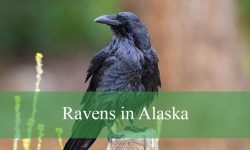California is home to a remarkable variety of ant species, from tiny nuisance invaders to aggressive fire ants and impressive carpenter ants. These insects play both beneficial and problematic roles in the state’s ecosystems and urban environments.
While some ants are helpful as natural pest controllers and seed dispersers, others can damage wood, infest homes, or deliver painful stings. Knowing how to recognize different species is the first step to managing them effectively.
This guide highlights 19 types of ants in California, with pictures and identification tips. You’ll learn about their characteristics, behavior, and habitats to better understand which ants you might encounter.
Different Types of Ants Found in California
Argentine Ant
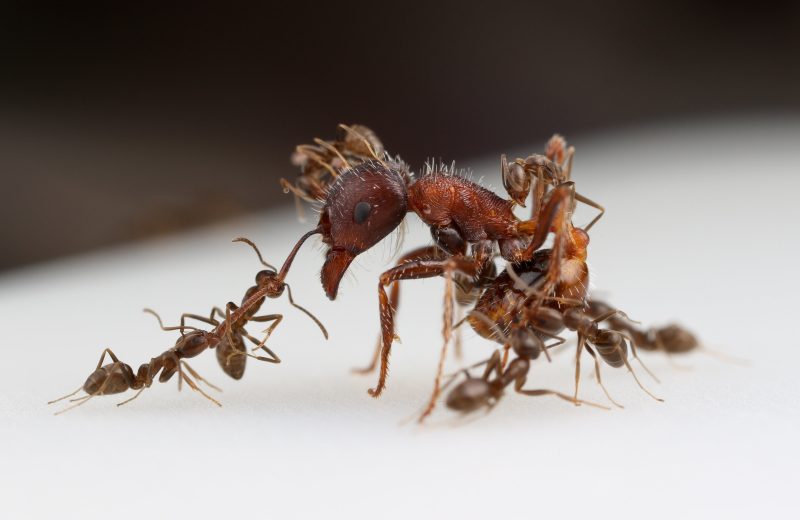
The Argentine ant is one of the most invasive species in California, originally introduced from South America. It is highly adaptable and thrives in both urban and agricultural environments, making it a major household pest. Colonies are massive, often containing multiple queens, which helps the species spread rapidly and dominate native ant populations. These ants prefer moist habitats but can adapt to a wide variety of conditions.
In terms of identification, Argentine ants are small, measuring about 2.2 to 2.8 millimeters in length. They are light to dark brown in color, with a smooth and shiny body. Unlike many other ants, they do not have a noticeable stinger. Their trails are often seen along sidewalks, walls, and inside homes, forming large, well-defined lines as they search for food.
Their diet is extremely broad, consisting of sweets, proteins, and oils. They are particularly drawn to sugary substances such as honeydew from aphids, which they protect and farm. This behavior creates ecological problems, as it disrupts the balance between plants and other insects. In homes, they will invade kitchens and pantries, contaminating food sources.
Behaviorally, Argentine ants are aggressive toward other ant species and often drive out native ants. They do not bite or sting humans but can become a nuisance due to their sheer numbers. Their colonies are interconnected, forming “supercolonies” that stretch for miles, making eradication difficult. Effective control often requires both baiting and environmental management.
Black Harvester Ant (Veromessor pergandei)
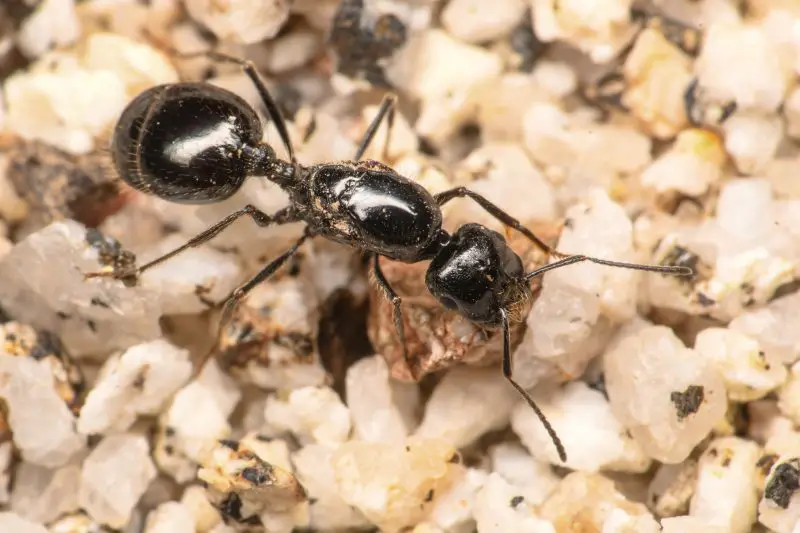
The Black Harvester ant is native to arid regions of California and is well-known for its seed-gathering habits. These ants play an important role in the ecosystem by dispersing seeds and influencing plant growth. Colonies are typically established in dry, sandy, or rocky soils, and their nesting sites are often marked by cleared areas around the entrance.
Identification of this species is relatively straightforward. Workers range in size from 5 to 7 millimeters and are black in color, with a robust body and long legs. Their large heads and strong mandibles are adapted for carrying seeds and defending the colony. Unlike some ants, they do not follow strict trails but instead scatter as individuals while foraging.
These ants are primarily granivores, storing seeds inside their underground chambers for later consumption. They also occasionally feed on small insects, especially when seeds are scarce. The seed-harvesting activity of Black Harvester ants can impact plant communities, both positively by spreading seeds and negatively by reducing the seed bank available for germination.
In terms of behavior, Black Harvester ants are generally not aggressive toward humans but can deliver a painful bite if disturbed. They are slow to move and often forage during the cooler parts of the day to avoid extreme desert heat. Their colonies are long-lived, and their activity patterns are closely tied to seasonal rainfall.
Small Honey Ant (Prenolepis imparis)
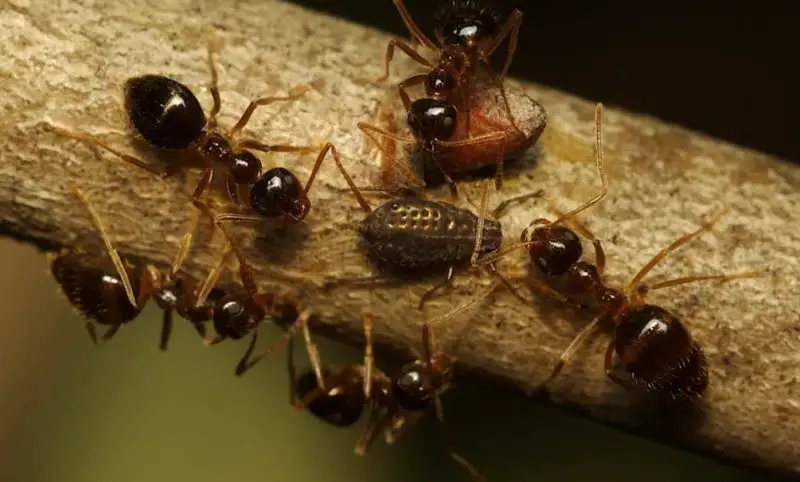
The Small Honey ant, also known as the winter ant, is unique because it is active during cooler months when many other ant species are dormant. This gives them a competitive advantage, as they can forage with little competition for resources. They are commonly found in shaded, moist habitats such as woodlands, gardens, and near buildings.
Workers of this species are tiny, typically measuring 2.5 to 3.5 millimeters in length. They are light to dark brown, with a shiny appearance and a slightly constricted waist. Their antennae are 12-segmented, and the body is relatively smooth compared to other small ant species. Colonies often contain hundreds of workers and one or more queens.
Small Honey ants feed primarily on honeydew produced by aphids and scale insects, making them an important part of the ecological balance in plant communities. They also consume nectar, sugary liquids, and occasionally small insects. Indoors, they may be found foraging for sweets but are not considered a major household pest.
Behaviorally, these ants are docile and non-aggressive toward humans. They do not sting and rarely bite, making them harmless from a human perspective. Their most distinctive trait is their seasonal activity—workers are frequently observed in late fall, winter, and early spring, disappearing when temperatures become too hot.
California Harvester Ant (Pogonomyrmex californicus)
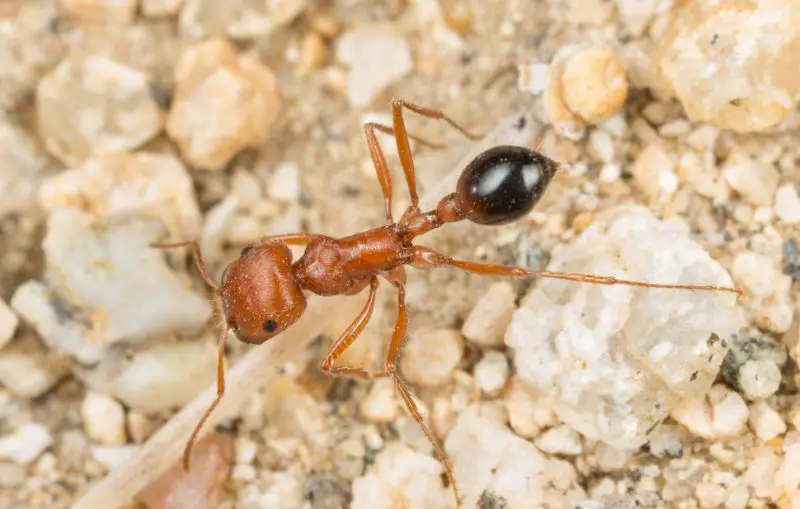
The California Harvester ant is one of the most recognizable ants in the state, commonly seen in open habitats such as deserts, grasslands, and chaparral areas. These ants are important seed collectors, contributing to soil aeration and plant distribution. Their nests are often surrounded by bare soil due to their clearing of vegetation around the entrances.
Workers are medium-sized, measuring between 5 and 7 millimeters. They are reddish-brown to orange in color, with a rough-textured body covered in fine hairs. Their powerful mandibles are well-suited for breaking apart seeds and defending the colony. The large head and sturdy thorax give them a distinctive, robust appearance.
Their diet mainly consists of seeds, which they collect and store in underground granaries. However, they will also feed on small insects when available. Colonies are large and can persist for many years, with workers venturing far from the nest in search of food. Their foraging trails are often visible as well-worn paths in sandy soils.
In terms of behavior, California Harvester ants are known for their painful sting, which is used as a defense mechanism. While they generally do not seek out humans, they will sting if the nest is disturbed. Despite their sting, they are ecologically beneficial, as their seed dispersal supports the growth of native plants.
Velvety Tree Ant (Liometopum occidentale)
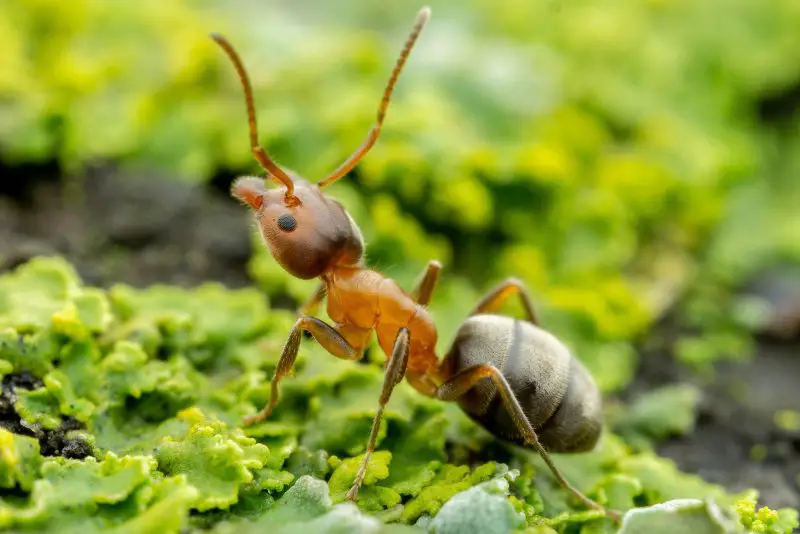
The Velvety Tree ant is a native Californian species that typically inhabits forests and woodlands. They are most often found nesting inside decayed wood, tree cavities, or beneath bark. These ants are named for their distinctive velvety appearance and are known to be one of the more aggressive ant species in the region.
Workers measure about 3 to 7 millimeters in length, with a black head and thorax and a reddish-brown gaster covered in fine hairs. This gives them a velvety sheen that makes them easily identifiable. Their long legs and fast movements distinguish them from slower-moving ground-dwelling ants.
Their diet consists of honeydew from sap-sucking insects, nectar, and small arthropods. They are aggressive predators and play a role in controlling pest populations, but they also protect aphids for their sugary secretions. In residential areas, they may invade homes in search of sweets and protein-rich foods.
Behaviorally, Velvety Tree ants are highly defensive of their colonies. They do not sting but can inflict painful bites and spray formic acid, which causes irritation to the skin. Their trails are often seen along tree trunks and wooden fences. Colonies can be very large, and their aggressive nature makes them difficult to control once they establish in an area.
Rough Harvester Ant (Pogonomyrmex rugosus)
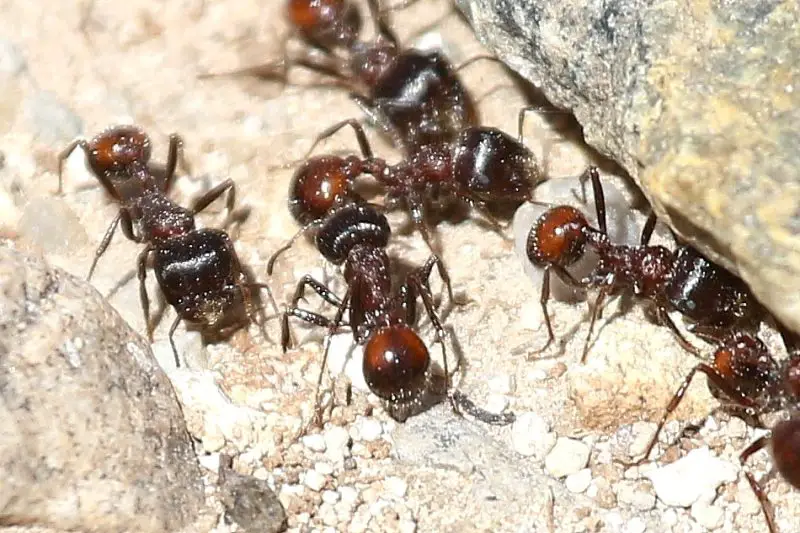
The Rough Harvester ant is a common species in California’s desert and arid grassland regions. These ants are named for the rough texture of their exoskeleton, which helps them withstand harsh environments. They are well adapted to sandy and rocky soils, where they construct large nests that can be recognized by cleared, circular patches around the entrances.
Workers measure between 6 and 8 millimeters and have a reddish-brown to dark brown coloration. Their bodies are covered in fine ridges, giving them a rugged appearance compared to smoother-bodied ants. Their large heads and strong mandibles are highly developed, allowing them to process seeds and defend their colonies.
As seed harvesters, their diet primarily consists of a wide variety of seeds, which they carry back to underground chambers for storage. They also feed on insects occasionally when plant-based food sources are limited. The seed-hoarding behavior of Rough Harvester ants plays an important ecological role, as they help distribute seeds and enhance soil fertility.
Behaviorally, these ants are highly territorial and can deliver an extremely painful sting. They are considered one of the more aggressive harvester ants, often defending their nests vigorously when disturbed. Despite this, they avoid unnecessary contact with humans unless provoked. Their foraging activity is usually highest during the morning and late afternoon when desert temperatures are more moderate.
Veromessor andrei
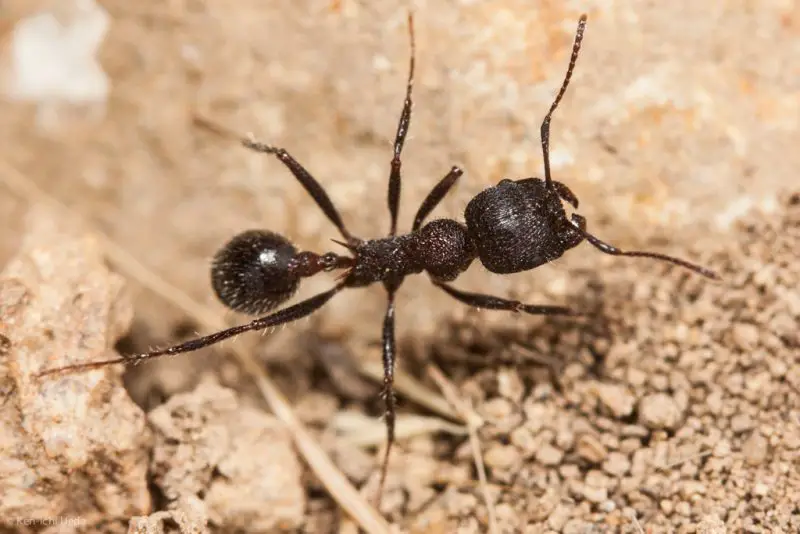
Veromessor andrei is a native harvester ant found in coastal and inland regions of California. These ants thrive in dry habitats, including chaparral, scrubland, and open fields. Their colonies are typically underground and can reach significant depths, helping them survive in areas prone to drought.
Workers vary in size, usually ranging from 4 to 6 millimeters. They are dark brown to black in coloration, with a slightly glossy body. Unlike some other harvester ants, Veromessor andrei has a relatively slender appearance, and workers may appear less robust. Their mandibles, however, are strong enough to handle seeds and small food items.
This species feeds primarily on seeds, similar to other harvester ants, but they also scavenge dead insects and other organic material. Colonies are often large and capable of storing significant amounts of food underground. Their foraging lines can sometimes extend long distances from the nest, with workers maintaining consistent trails to food sources.
In terms of behavior, Veromessor andrei is less aggressive than Pogonomyrmex species. They can bite but are not known for delivering painful stings. They are, however, efficient at defending their resources from competing ants. Their colonies contribute to soil turnover and seed dispersal, which benefits native plant communities.
Odorous House Ant (Tapinoma sessile)
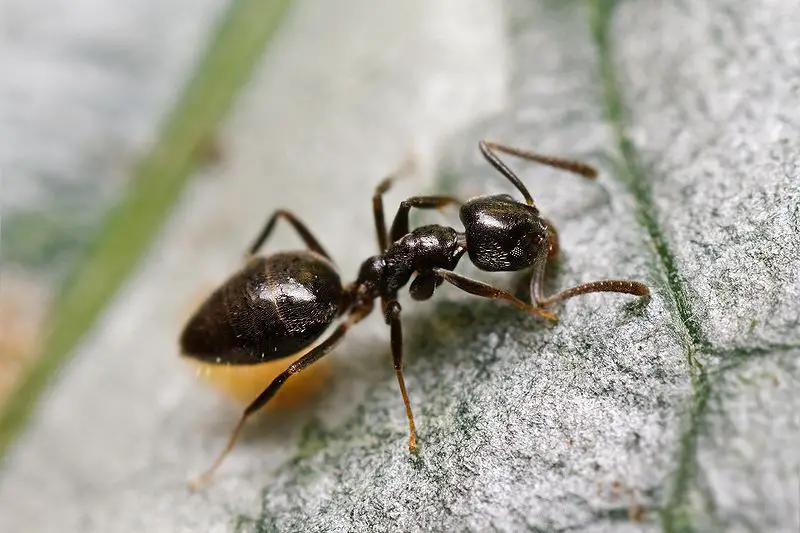
The Odorous House ant is one of the most widespread household pests in California. True to its name, when crushed, it emits a strong, rotten coconut-like odor that makes it easy to identify. These ants thrive in both urban and natural environments, nesting in soil, mulch, wall voids, and beneath stones or logs.
Workers are small, usually 2.4 to 3.3 millimeters in length, and are brown to black in coloration. Their bodies are smooth and shiny, with a single hidden node that is not easily visible. Colonies are often large, with multiple queens, which allows them to expand quickly and dominate areas once established.
Their diet consists mainly of sugary substances such as honeydew, nectar, and household sweets. They are also opportunistic feeders, consuming proteins and greasy foods when available. Indoors, they commonly invade kitchens and pantries, contaminating stored food. Outdoors, they tend to associate with aphids and scale insects for honeydew.
Behaviorally, Odorous House ants are highly adaptable and form extensive trails between food sources and nests. They do not sting, but their strong odor makes them unpleasant pests. Colonies can relocate quickly if disturbed, which makes control efforts challenging. Their resilience and ability to exploit diverse habitats make them one of the most persistent ant species in California.
Bicolored Carpenter Ant (Camponotus vicinus)
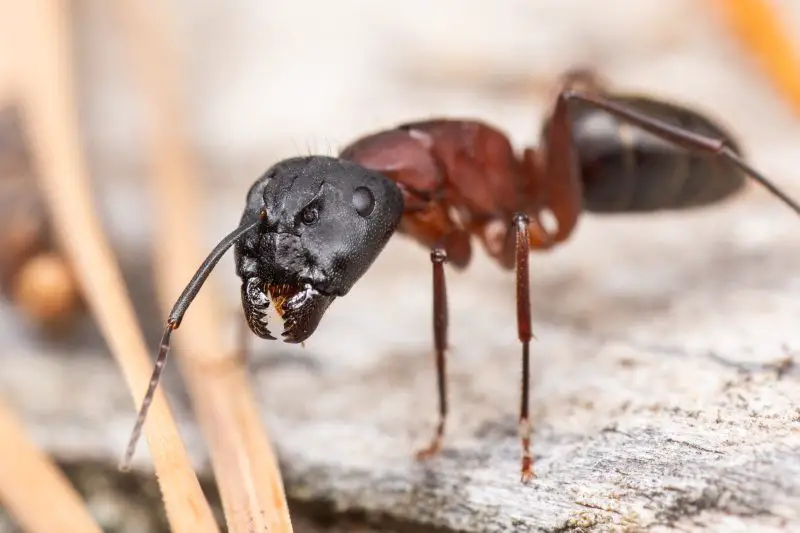
The Bicolored Carpenter ant is a large ant species commonly found in forests, woodlands, and residential areas of California. Unlike some ants, they do not eat wood but excavate it to create their nesting galleries. These ants can cause structural damage if they infest wooden buildings or furniture.
Workers are relatively large, ranging from 6 to 10 millimeters in length. They are easy to identify by their striking coloration: a reddish-brown thorax contrasting with a black head and gaster. Their robust bodies and long legs make them appear more formidable than smaller household ants.
Their diet is diverse, consisting of plant nectars, honeydew, insects, and household food scraps. They are particularly drawn to sweet substances and can often be found foraging in kitchens or gardens. Colonies usually establish in dead or decayed wood, tree stumps, or wooden structures.
Behaviorally, Bicolored Carpenter ants are not aggressive toward humans and rarely bite unless provoked. However, their tunneling habits inside wood make them economically significant pests. They are mostly nocturnal foragers, with workers traveling long distances from the nest in search of food. Effective management requires locating and eliminating their nesting sites.
Western Carpenter Ant (Camponotus modoc)
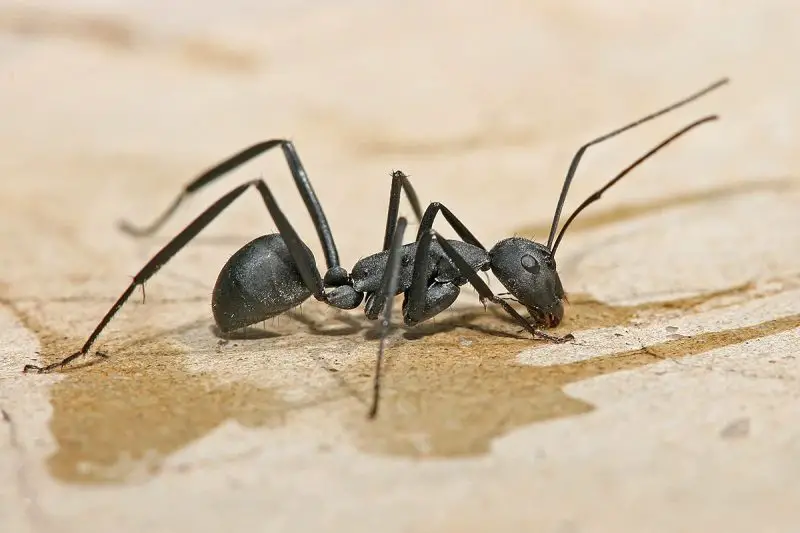
The Western Carpenter ant is another large carpenter ant species present in California, particularly in cooler, forested regions. Like other carpenter ants, they excavate wood to build nests rather than consuming it, making them a potential threat to wooden structures. They are often found in both natural and urban environments.
Workers measure between 6 and 13 millimeters, making them among the largest ants in California. Their coloration is usually black, sometimes with reddish hues on the thorax. Their powerful mandibles and sturdy bodies are well adapted for wood excavation and defense. They are easily distinguished from smaller ant species by their size alone.
Their diet consists of plant juices, honeydew, and insects. They also forage inside homes for sweets, meats, and fats. Colonies may contain thousands of workers and one or more queens, and they typically prefer nesting in moist or decayed wood, which is easier to excavate.
Behaviorally, Western Carpenter ants are persistent foragers and can travel up to 100 yards from their nests. They do not sting but can bite if handled, sometimes spraying formic acid into the wound, which causes mild irritation. Their ability to damage structural wood makes them important pests that require professional control when infestations occur.
Southern Fire Ant (Solenopsis xyloni)
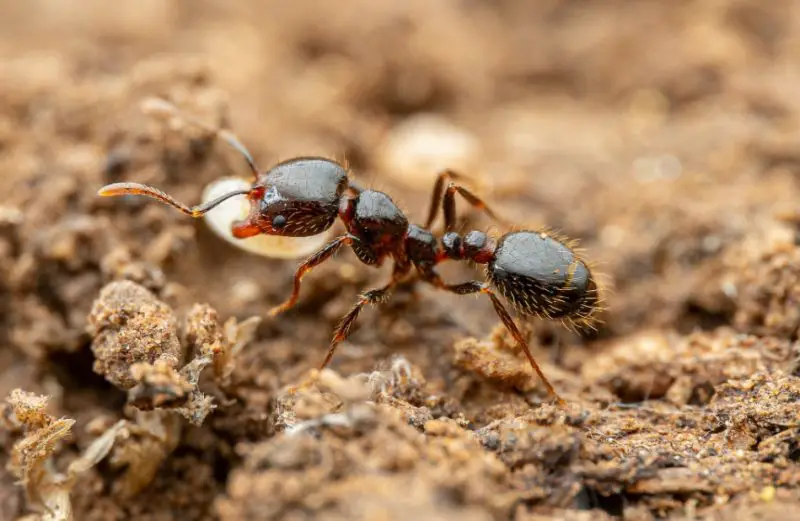
The Southern Fire ant is a widespread species in California, especially in warmer and drier regions. It is closely related to the notorious Red Imported Fire ant, though less invasive. These ants prefer nesting in soil, often near sidewalks, lawns, or under rocks. Their colonies can contain multiple queens, which helps them expand quickly in suitable habitats.
Workers are small to medium-sized, ranging from 2 to 6 millimeters in length. They are bicolored, with reddish-brown heads and thoraxes and darker abdomens. This coloration helps distinguish them from other fire ant species. Their mandibles are strong, and their bodies are sleek and shiny, giving them a distinctive appearance.
Their diet is highly varied, including sweets, proteins, seeds, and insects. They are aggressive foragers and can quickly overrun food sources, both indoors and outdoors. Southern Fire ants often tend aphids for honeydew, further enhancing their ability to thrive in gardens and agricultural areas.
Behaviorally, these ants are aggressive and capable of delivering painful stings. Their sting can cause burning pain, redness, and in sensitive individuals, allergic reactions. Colonies defend themselves vigorously when disturbed, making them a concern in residential and recreational areas. Despite their aggressive nature, they are important predators of insect pests in natural ecosystems.
Dark Rover Ant (Brachymyrmex patagonicus)

The Dark Rover ant is a relatively new invader in California, originally from South America. It has adapted well to urban and suburban environments, where it can be found nesting in soil, leaf litter, and cracks in pavement. Colonies are small compared to other invasive ants but are widespread due to their adaptability.
Workers are tiny, measuring only 1.5 to 2 millimeters long, making them one of the smallest ant species in California. They are dark brown to almost black, with short antennae and a small, oval-shaped body. Their size and dark coloration make them difficult to notice until infestations become large.
These ants are opportunistic feeders, consuming sweets, greasy foods, and proteins. Outdoors, they are often associated with honeydew-producing insects. Indoors, they frequently invade kitchens and bathrooms in search of sugary liquids. Their small size allows them to enter through tiny cracks and crevices.
Despite their small stature, Dark Rover ants are persistent and resilient. They do not sting and rarely bite, but their infestations can be difficult to control due to their scattered nesting habits. Colonies reproduce quickly, and once established, they can become a constant nuisance in households and commercial buildings.
Immigrant Pavement Ant (Tetramorium immigrans)
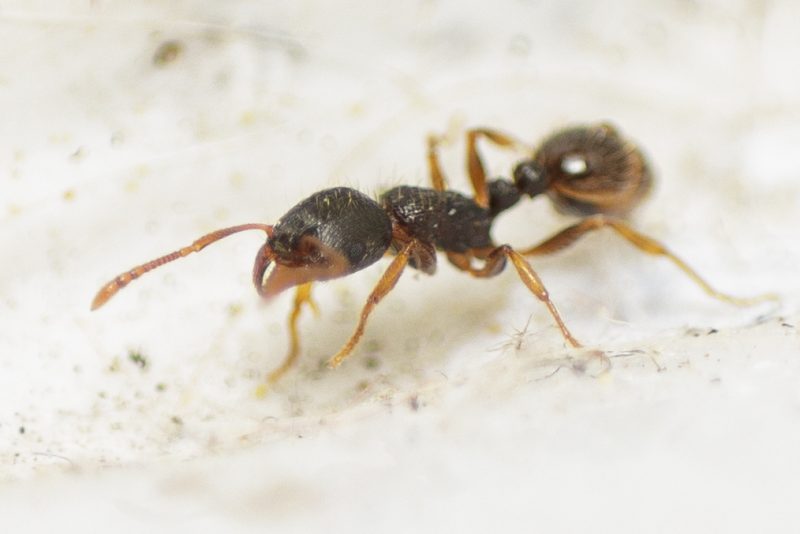
The Immigrant Pavement ant is one of the most common urban ants in California. It was introduced from Europe and has since spread widely across North America. True to its name, it often nests under pavement, sidewalks, and building foundations, where colonies are well-protected.
Workers measure 2.5 to 4 millimeters in length and are dark brown to black in color. Their bodies are marked by fine parallel grooves on the head and thorax, making them easy to identify under magnification. They also have two spines on the thorax, a trait that sets them apart from many other small ant species.
Their diet is extremely broad, including sweets, greasy foods, dead insects, and seeds. Indoors, they frequently invade kitchens and food storage areas. Outdoors, they scavenge widely and compete with other ant species for resources. Their ability to thrive in urban environments makes them one of the most persistent house-invading ants.
Behaviorally, Pavement ants are aggressive toward other ant colonies, often engaging in large battles on sidewalks or driveways during spring and summer. They do not sting but can bite, though their bite is mild. Colonies may contain thousands of workers and multiple queens, enabling rapid population growth in cities.
Bicolored Pyramid Ant (Dorymyrmex bicolor)
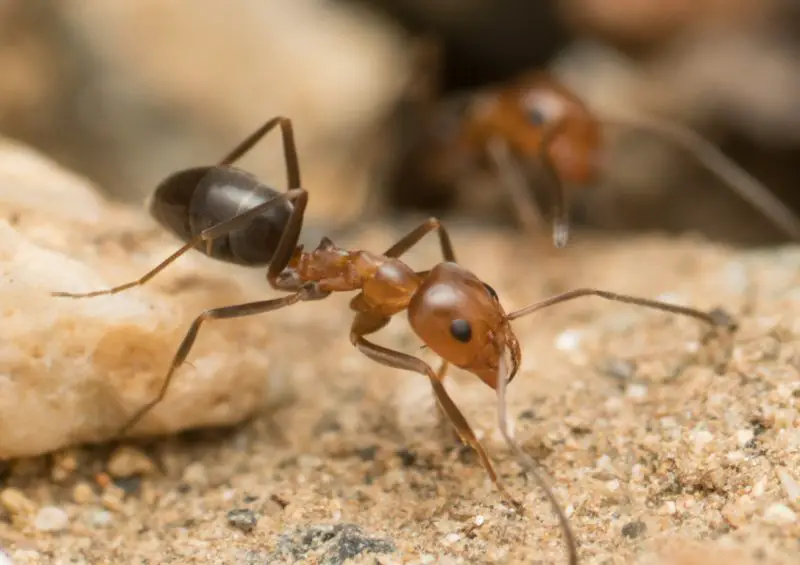
The Bicolored Pyramid ant is a unique species found in California’s arid and semi-arid regions. It is easily recognized by the raised pyramid-shaped structure on its thorax. These ants typically nest in open sandy soils, often creating small, circular mounds with a single entrance hole.
Workers are about 2.5 to 4 millimeters long. They are distinctly bicolored, with reddish-brown heads and thoraxes and dark brown to black abdomens. Their slender bodies and quick, erratic movements make them noticeable when foraging in open areas.
Their diet primarily consists of live and dead insects, making them effective predators. They also consume honeydew from aphids and nectar from flowers. Unlike many other ants, they are less attracted to household foods and are not considered major indoor pests.
Behaviorally, Bicolored Pyramid ants are fast-moving and aggressive toward prey but generally non-aggressive toward humans. They do not sting and rarely bite, making them harmless in residential settings. Their ecological role as insect predators is important, as they help control populations of other insects in arid ecosystems.
Western Thatching Ant (Formica obscuripes)
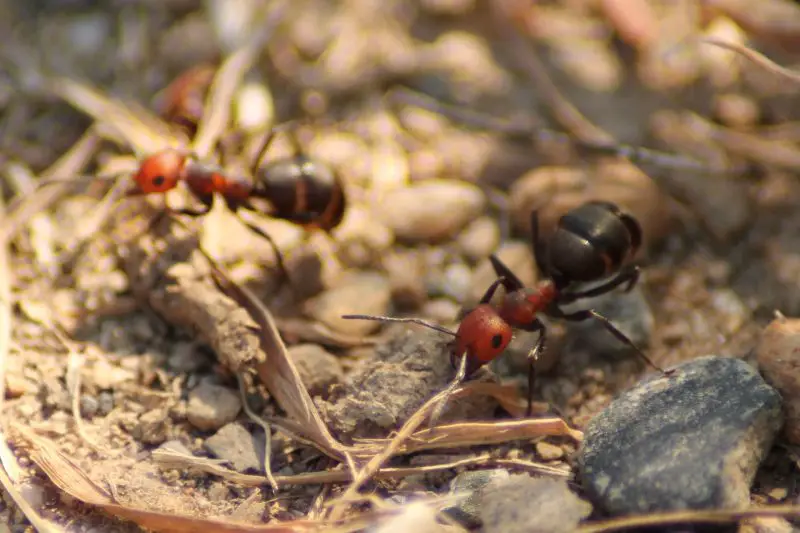
The Western Thatching ant is a large ant species known for building thatch mounds from twigs, pine needles, and plant material. These mounds can be quite large, sometimes reaching several feet in diameter, making them highly visible in forested and grassland habitats of California.
Workers range from 4 to 8 millimeters in length and are reddish-brown with darker abdomens. Their strong mandibles and large eyes make them efficient foragers and defenders. Colonies are usually massive, with tens of thousands of workers and multiple queens.
Their diet consists of honeydew, nectar, insects, and carrion. They are active hunters and scavengers, often seen foraging in large numbers. They also protect aphid colonies to secure a steady supply of honeydew. Their strong foraging presence influences the insect communities in their habitats.
Behaviorally, Western Thatching ants are very aggressive when defending their nests. They do not sting but can deliver painful bites and spray formic acid, which causes irritation. Their large, conspicuous mounds and defensive behavior make them both impressive and intimidating in natural landscapes.
Monomorium ergatogyna
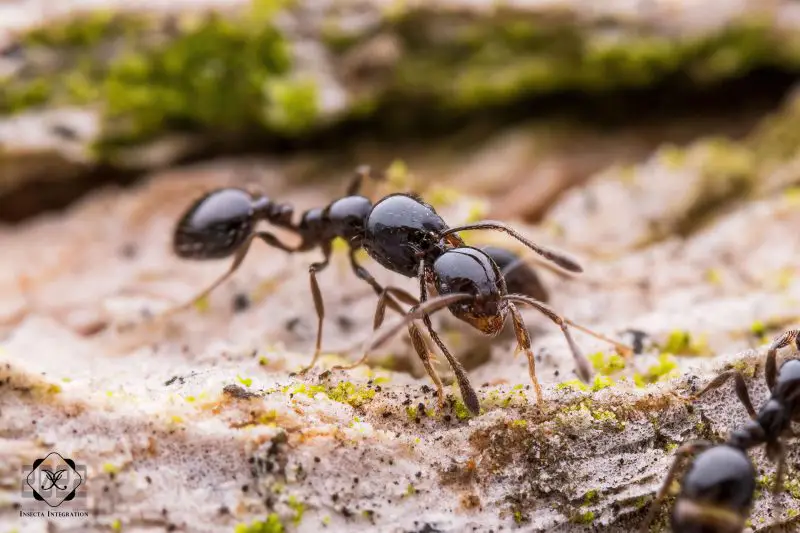
Monomorium ergatogyna is a small native ant species commonly found in coastal and urban areas of California. It prefers dry, sandy soils but is also highly adaptable, nesting in lawns, gardens, and beneath rocks or debris. Colonies are relatively small compared to invasive ant species, but they can still become noticeable in residential settings.
Workers are tiny, typically measuring only 2 to 2.5 millimeters in length. They are yellowish-brown to light brown in coloration, with slender bodies and short antennae. Their small size makes them difficult to distinguish from other nuisance ants without close inspection. Unlike larger ants, they often go unnoticed until they invade kitchens or pantries.
Their diet is varied, consisting of sweets, proteins, and oils. Outdoors, they forage for honeydew, nectar, and dead insects. Indoors, they are attracted to sugary foods and greasy residues, making them common household invaders. Colonies may contain multiple queens, which enables them to reproduce efficiently and maintain stable populations.
Behaviorally, Monomorium ergatogyna is not aggressive toward humans and does not sting. They can bite, but it is mild and harmless. Their main nuisance comes from their persistence in entering homes in search of food. Effective control usually requires eliminating food sources and using baiting strategies to reduce colony numbers.
Formica moki
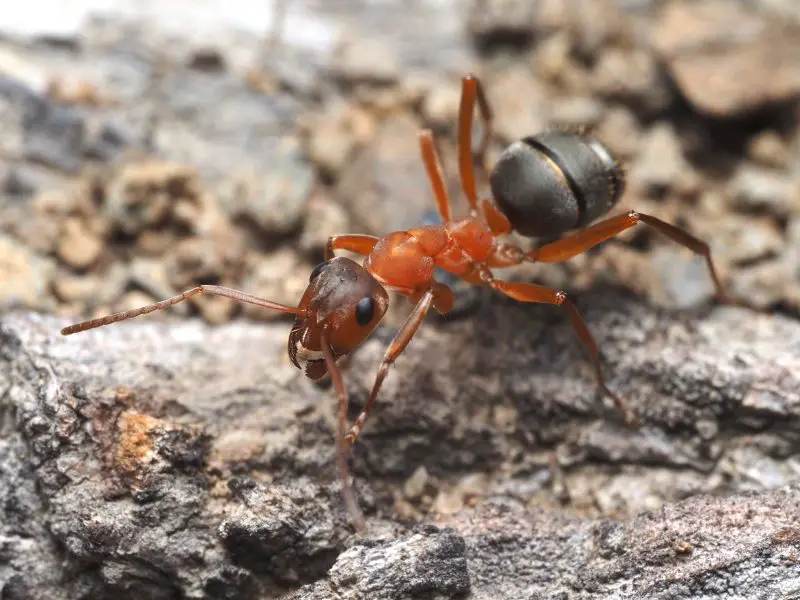
Formica moki is a native ant species widely distributed across California’s woodlands, grasslands, and chaparral areas. It plays an important role in natural ecosystems by preying on insects and helping with soil aeration. Colonies are often located under rocks, logs, or in soil, and they may expand to form large populations.
Workers are medium-sized, measuring 4 to 6 millimeters in length. They are dull brown to black in coloration, with slightly shiny bodies and long legs. Their appearance is somewhat similar to other Formica species, but they can be recognized by their relatively uniform body color and fast movements.
This species has a generalist diet, feeding on honeydew, plant nectars, and insects. They are important predators of pest insects, which makes them beneficial in natural and agricultural environments. They are also attracted to household sweets, though they are not considered major indoor pests.
Formica moki is moderately aggressive toward other ants but not particularly harmful to humans. They do not sting, though they can bite, and they sometimes spray formic acid as a defense. Their colonies are large and well-organized, and their trails can often be seen extending long distances between food sources and nesting sites.
Hairy Smooth Carpenter Ant (Camponotus laevissimus)
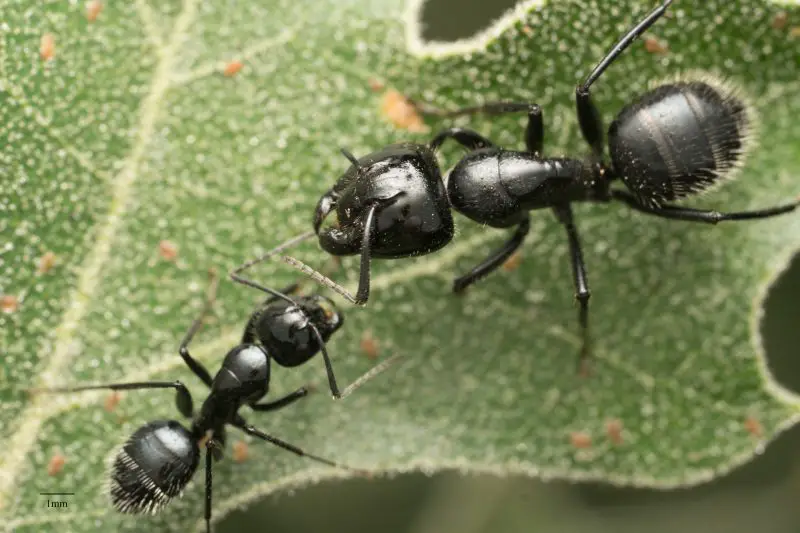
The Hairy Smooth Carpenter ant is one of the largest carpenter ants found in California. As with other carpenter ants, it does not consume wood but excavates it to create nests. This behavior makes it a potential structural pest when it infests wooden buildings or furniture.
Workers range in size from 6 to 12 millimeters, with a black body that has a smooth, shiny surface. The species gets its name from the fine hairs that cover its body, which are visible under close inspection. Its robust form, large mandibles, and glossy appearance make it easy to identify compared to smaller ant species.
Its diet includes honeydew, plant nectar, dead insects, and household food scraps. These ants are strong foragers, often traveling far from their nests in search of resources. Outdoors, they prefer nesting in decayed or moist wood, tree stumps, and logs, but indoors they can tunnel into structural wood.
Behaviorally, Hairy Smooth Carpenter ants are not aggressive and rarely bite humans. They do not sting, but their wood-excavating habits can cause economic damage over time. Colonies are large and long-lived, making infestations persistent if not addressed. They are primarily nocturnal, with workers most active at night.
Red Imported Fire Ant (Solenopsis invicta)
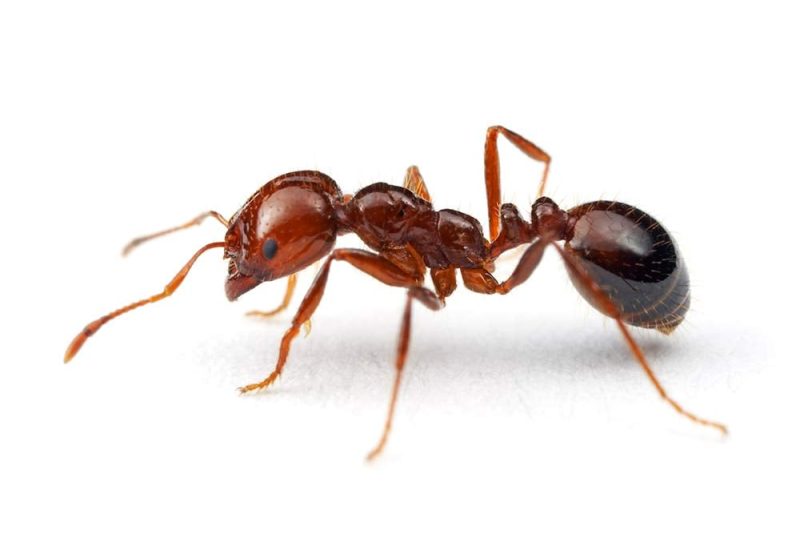
The Red Imported Fire ant is one of the most notorious invasive ants in California, introduced from South America. It is known for its aggressive behavior, painful stings, and ability to establish massive colonies. These ants are a serious pest in residential, agricultural, and natural environments.
Workers vary greatly in size, ranging from 2 to 6 millimeters, with reddish-brown bodies and darker abdomens. Their colonies are large, with multiple queens, and nests are typically built in soil, often forming visible mounds in lawns, fields, or along sidewalks. Their polymorphic worker caste gives them an advantage in performing different tasks efficiently.
Their diet is highly diverse, including seeds, plant material, honeydew, insects, and even small vertebrates. They are aggressive foragers and quickly dominate food sources. In agricultural areas, they can cause damage by feeding on crops and interfering with farm equipment. Indoors, they invade homes in search of sweets, proteins, and greasy foods.
Behaviorally, Red Imported Fire ants are extremely aggressive and defend their colonies in large numbers. They deliver painful, venomous stings that cause burning sensations, pustules, and allergic reactions in sensitive individuals. Because of their invasive nature and impact on both ecosystems and human activities, they are considered one of the most problematic ants in California.
FAQs about Ants in California
What are the most common ants in California?
Some of the most common ants in California include Argentine ants, Odorous House ants, Pavement ants, Harvester ants, and Carpenter ants. These species are widespread in both urban and natural areas, often invading homes, gardens, and agricultural land.
Do carpenter ants in California eat wood?
No, carpenter ants such as the Bicolored Carpenter ant and Western Carpenter ant do not eat wood. Instead, they excavate it to create nests, which can still cause structural damage to homes and buildings over time.
Are fire ants found in California?
Yes, California is home to both the Southern Fire ant and the invasive Red Imported Fire ant. Both species are aggressive and deliver painful stings, with the Red Imported Fire ant posing a bigger threat due to its rapid spread and impact on ecosystems.
How can I identify Argentine ants in California?
Argentine ants are small (2–3 mm long), light to dark brown, and form massive colonies with multiple queens. They travel in long trails and are commonly found indoors, especially in kitchens, searching for sweets and water.
Do ants in California bite or sting?
Yes, some ants bite, and others sting. Harvester ants and Fire ants are well known for their painful stings, while Carpenter ants can bite if threatened. Many nuisance ants like Odorous House ants or Pavement ants do not sting and are more of a household annoyance.
What ants are considered invasive in California?
The most invasive ant species in California are Argentine ants, Red Imported Fire ants, and Dark Rover ants. These ants spread aggressively, displace native species, and often become major pests in homes and gardens.
Are ants in California dangerous to humans?
Most ants in California are not dangerous, though they can contaminate food and become household pests. The main health risks come from Fire ants, which sting and can trigger allergic reactions. Carpenter ants are not harmful to health but can damage wooden structures.
How do I get rid of ants in California homes?
Effective ant control involves eliminating food sources, sealing entry points, and using baiting systems. For invasive or aggressive species like Carpenter ants or Fire ants, professional pest control may be necessary to fully remove colonies.
Do ants in California help the environment?
Yes, many native ants play a vital ecological role. Harvester ants disperse seeds, Formica species control insect populations, and thatching ants improve soil structure. Problems mainly arise with invasive ants that disrupt these natural balances.






